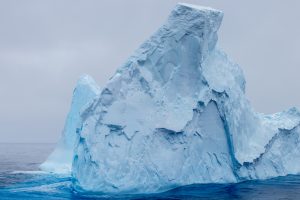13 April 2017
Researchers unravel drivers of large iceberg movement
Posted by Nanci Bompey
Tabular icebergs can drift through the Southern Ocean for eight years or more, and predominantly melt at the bottom
By Sina Löschke
When, in the foreseeable future, a tabular iceberg nearly seven times the size of Berlin breaks off the Larsen C Ice Shelf in the Antarctic, it will begin a journey, the course of which climate researchers at the Alfred Wegener Institute, Helmholtz Centre for Polar and Marine Research can accurately predict.
The researchers have succeeded in modeling how Antarctic icebergs drift through the Southern Ocean, and in identifying the physical factors behind their movement and their melting. Which factors are most important tends to depend on the size of the iceberg in question. Their findings were recently published in Journal of Geophysical Research: Oceans, a journal of the American Geophysical Union.
Predicting iceberg movement
Polar researchers around the globe are watching the Antarctic Peninsula with bated breath. On the Larsen C Ice Shelf, a massive iceberg has begun to break off. The future iceberg will be roughly 175 kilometers long, and will measure 50 kilometers across at its widest point. As such, it will have a total surface area of nearly 6,000 square kilometers, making it seven times the size of the greater Berlin metropolitan area. Further, at about 1,300 gigatonnes, the colossus will weigh nearly as much as all of the new icebergs formed in the Antarctic in the course of an average year.
It is virtually impossible to predict exactly when ice masses of this size will calve. However, climate researchers at the Alfred Wegener Institute can now better predict how small, medium-sized, and large icebergs will drift through the Southern Ocean once they have broken off from their ice shelf, and which physical factors are responsible for their movements – these factors can vary greatly, depending on their size.
Varying factors

An iceberg surrounded by sea ice, in the Weddell Sea.
Credit: Alfred-Wegener-Institut/ Mario Hoppmann
“Icebergs that aren’t longer or wider than two kilometers normally drift away from the ice shelf edge and out of coastal waters within a few months. The wind pushes them out to the open sea, where they ultimately break up into smaller pieces and melt in the course of two to three years,” explains Thomas Rackow, a climate modeler at the Alfred Wegener Institute in Bremerhaven and first author of the new study.
When it comes to mammoths on the scale of the Larsen C candidate, the wind is largely irrelevant. Instead, the icebergs’ motion is chiefly driven by their own weight, and by the fact that the surface of the Southern Ocean is not flat, but instead leans to the north. As a result, sea level can be up to 0.5 meters higher on the southern edge of the Weddell Sea or along the Antarctic Peninsula than at its center.
“When large icebergs drift, they initially slide down the inclined ocean surface, but not along a straight line; they tend to veer to the left. This is due to the Coriolis force, which is a consequence of the Earth’s rotation and ultimately puts the icebergs on a course parallel to the coast, one similar to the Antarctic Coastal Current,” Rackow said.
Heading north

All modeled iceberg trajectories for the full 12-year simulation. One can
see four different highways, which are taken by many icebergs on their way north.
Credit: Alfred-Wegener-Institut/ Thomas Rackow
The deflecting effect of the Coriolis force also explains why large tabular icebergs linger near the coast for the first three or four years. Many only make their way to the open sea once the Antarctic Coastal Current leads them away from the coast – or once they become trapped in pack ice, and the wind drives pack ice and iceberg collectively away from the coast.
“In this way, even the large tabular icebergs end up in more northerly ocean regions with warmer water,” says Rackow.
Once in warmer waters, the tabular icebergs start to melt at the bottom and, depending on their point of origin, follow one of the four “highways” that transport all floating ice in the Antarctic northwards.
One of these iceberg highways follows the eastern coast of the Antarctic Peninsula, leading from the Weddell Sea toward the Atlantic. There is a second “exit” at the Prime Meridian, on the eastern edge of the Weddell Sea – at roughly the same point where Germany’s Antarctic research station Neumayer III is located on the Ekström Ice Shelf. The third exit is at the Kerguelen Plateau in the eastern Antarctic, while the fourth leads the ice northwards from the Ross Sea.
Once they have begun their journey north, some large icebergs make it as far as the 60th parallel south, covering thousands of kilometers before they disappear. Some have even been sighted off the coasts of South America and New Zealand.
Tracking the Larsen C iceberg
How far the future Larsen C iceberg will drift depends on whether it remains intact after calving, or quickly breaks up into smaller pieces. Further, the iceberg may run aground for a time.
“If it doesn’t break up, chances are good that it will first drift for about a year through the Weddell Sea, along the coast of the Antarctic Peninsula. Then it will most likely follow a northeasterly course, heading roughly for South Georgia and the South Sandwich Islands,” according to Rackow.
Given its massive weight, the Larsen C iceberg will likely survive for eight to 10 years. According to the computer model, that’s the maximum life expectancy for even the largest “white wanderers”.
Modeling icebergs
For the new study, the study’s authors fed actual position and size data of 6,912 Antarctic icebergs into the Finite Element Sea Ice-Ocean Model FESOM, which they combined with a dynamic-thermodynamic iceberg model, both of which were developed at the AWI. The researchers subsequently simulated how the icebergs would drift and melt over a 12-year timespan.
The potential routes produced by the model were then compared with actual data on large icebergs from the Antarctic Iceberg Tracking Database, and with positioning data from GPS transmitters that the AWI had installed on various icebergs in the Weddell Sea in the years 2000 and 2002.
“The primary goal of our study was to understand in which region of the Southern Ocean the large icebergs melt, adding massive quantities of freshwater in the process. The fact that we have now also succeeded in unraveling the fundamental mechanisms so thoroughly is a wonderful extra bonus,” Rackow said.
— Sina Löschke is a press officer at the Alfred Wegener Institute, Helmholtz Centre for Polar and Marine Research. This post originally appeared as a press release on the AWI website.




 GeoSpace is a blog on Earth and space science, managed by AGU’s Public Information staff. The blog features posts by AGU writers and guest contributors on all sorts of relevant science topics, but with a focus on new research and geo and space sciences-related stories that are currently in the news.
GeoSpace is a blog on Earth and space science, managed by AGU’s Public Information staff. The blog features posts by AGU writers and guest contributors on all sorts of relevant science topics, but with a focus on new research and geo and space sciences-related stories that are currently in the news.
If the slope of the ocean is due to the gravitational attraction of the Antarctic land mass, then your statement “When large icebergs drift, they initially slide down the inclined ocean surface” cannot be true, as gravity will have just the same effect on the iceberg. Am I missing something here?